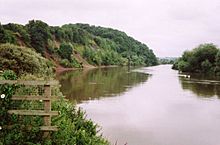Wainlode Cliff facts for kids
| Site of Special Scientific Interest | |

Wainlode Cliff
|
|
| Area of Search | Gloucestershire |
|---|---|
| Coordinates | 51°55′48″N 2°13′34″W / 51.930046°N 2.226104°W |
| Interest | Geological |
| Area | 1.3 hectare |
| Notification | 1954 |
Wainlode Cliff is a really special place in Gloucestershire, England. It's known as a Site of Special Scientific Interest (SSSI) because of its amazing rocks and history. This means it's protected to keep its unique features safe.
The cliff is about 1.3 hectares big, which is like two football fields! It became an SSSI in 1954. From Wainlode Cliff, you can look out over a beautiful area called Hasfield Ham.
Exploring the Ancient Rocks at Wainlode Cliff
Wainlode Cliff is a very important spot for scientists who study rocks and Earth's history. People first wrote about this place way back in 1842! It's like a giant history book made of stone.
What Can We See in the Cliff?
The cliff shows a seven-meter-thick section of rocks from a time called the Rhaetian age. This was about 200 million years ago, when dinosaurs were just starting to roam the Earth!
The rocks here are divided into two main layers:
- Westbury Beds: These are older rocks found at the bottom.
- Cotham Beds: These are younger rocks found above the Westbury Beds.
The Famous Insect Limestone
One of the most exciting parts of Wainlode Cliff is a special rock layer called the Insect Limestone. This rock is famous because it's full of fossilized insects! Scientists have found many different kinds of ancient insects here.
The Insect Limestone marks the beginning of a much larger rock formation called the Lias. The Lias is a huge group of rocks that tells us a lot about life on Earth during the early Jurassic period. Finding the Insect Limestone helps scientists understand exactly where the Lias begins.

